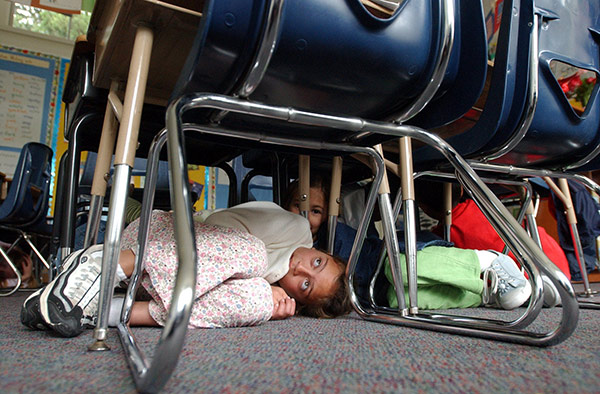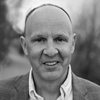Subtotal: $
Checkout
Waiting for Our Daughter during Another School Lockdown
A psychiatrist and parent asks if we will let it become acceptable that children live daily with fear and stress.
By Abraham M. Nussbaum
May 22, 2023
As a parent who is also a physician, I am accustomed to special requests from my children’s schools. Over the years, I have received welcome requests to judge science fairs critically and to introduce sex ed clinically. Lately, the schools have made a new request that feels unwelcomely like my clinical work: to wait out another school shooting.
Our neighborhood high school was locked down again recently. Standing in the middle of a busy street closed by our city’s police force and occupied by the region’s news stations, I tried to count how many times it had been this year. When I ran out of fingers, I lost track.
Now it was happening again. A block away, dozens of teachers were locked inside along with twenty-five hundred students. Our fifteen-year-old daughter was one of them. She texted her whereabouts to my wife and me. Gym. I am okay. Just stressful day.
I am a psychiatrist; we have strategies for stress. We distinguish worries, the daily anxieties, from the enduring paranoias. We measure adverse experiences, scoring childhood neglect higher than a recent breakup. We prescribe treatments, whether breathing exercises or behavioral therapies. We ask after stress behaviors, seeking the obsessions underlying bodily compulsions. Many of these stresses are part of the human condition.

An eight-year-old girl curls up under her desk during a lockdown drill at her elementary school. ZUMA Press, Inc. / Alamy Stock Photo
Our daughter and her classmates are becoming accustomed to stresses that I cannot accept as part of being human. All year long, their Denver high school has gone under lockdown for various threats. As a fellow parent reminded me, we’ve had far more days cancelled because of safety than because of snow. Then, the day before Valentine’s Day, a seventeen-year-old junior, Luis Garcia, was shot while sitting in his car outside of school. A few weeks later, he died at the hospital where I work. Days after he died, a thousand students left school and walked the two miles to the state capitol, demanding an end to gun violence.
By the end of the month, those same students were locked inside the school walls, awaiting an all-clear. It was slow to come because Austin Lyles, a seventeen-year old student, was on the loose. Lyles had shot two school administrators during his court-required morning search and then fled the scene. The school locked down and alerted parents that we could collect our children when the lockdown ended. We gathered outside in the streets, flitting anxiously behind a police cordon.
Our daughter and her classmates are becoming accustomed to stresses that I cannot accept as part of being human.
Parents acted out their own stresses in characteristic fashion. Some cried. Some yelled. Some paced. The communications director from the school district arrived and parents swarmed him on a street corner. Then the chief of police arrived. The mayor – and many of the sixteen candidates running to replace him – arrived as well. The swarm intensified. Parents pleaded for the swift release of their children, for safe schools, for the restoration of the police officers removed from the district’s schools three years ago. Pulled in by the crowd, I found myself in the swarm’s middle, close enough to touch the mayor and the police chief. Everyone else was recording the officials’ comments on their phones, so I began doing the same. That’s how crowds work, on a shared energy. Then a surge of my own stress ran through me. What can authorities say that will resolve our worries? What could this worried crowd do? Where is the gunman? Which of these people could also be a gunman?
I fell back from the crowd. Seeking my footing, I fell back on my clinical training.
I work on a locked inpatient psychiatry unit, where acts and threats of violence are commonplace. Workers on inpatient psychiatric units are, by some measures, 59 times more likely to be intentionally injured at work. We are accustomed to these moments, so we prepare. We have training and staff and security, but looking at my child’s school it was immediately clear that it lacked many of the protections that are in place for patients and workers in the hospital. Twenty-five poorly secured entrances. After the school board removed police officers, the school allowed a student expelled from other area schools to enroll, on a personalized behavioral plan, despite prior arrests for owning ghost guns including an AR-15–style rifle, without informing most staff. At that moment, the student was unaccounted for.
So I started accounting for what I could. I looked for the people I knew in the crowd and consulted them, as I would in the hospital. An internist who trained me in med school was nearby; we chatted about gun control. A paramedic who I’ve known for years was behind the swarm; we talked about the fortunate coincidence that medics were on site when the shooting occurred so that the injured administrators received immediate care which saved their lives. A community health worker who runs a violence intervention program was in the streets; she embraced me with an assuring hug. That was more helpful than anything emanating from the swarm of officials. I thanked her; she said, “This is what I do.”
I appreciated the sentiment, but her comment also chilled me. We have all become accustomed to the gun violence plaguing our congregate spaces. Comforting each other after another shooting is, sadly, what we all do. I thought again about my daughter’s texted comment. Just stressful day. She, like all of us, has become accustomed to school as a place where school administrators and teachers are shot, where seventeen-year-olds are killed, and where each new day could be another lockdown.
When the school finally released students, they walked quickly down the hill toward us, looking over the shoulders as they fell into the arms of their parents.
Our daughter made it safely home from school that day.
Luis Garcia did not. His family had buried him in the days before.
Neither did Austin Lyles, who would be found dead by suicide on the day of the lockdown.
Rates of murder and suicide by firearms continue to rise among America’s children and adolescents. I thought about this as we walked our daughter home. In a few weeks, I will teach medical students about suicide and public mental health, and I will confess that I don’t entirely know what to do about either. I share my fellow physician’s desire for gun control, but not her hopes. The political challenges are profound, and none of the legislation we are considering would stop someone determined to obtain a ghost gun. I surely want to stitch up our patchwork mental health systems. Colorado, despite its wealth, routinely ranks at or near the bottom of the states for mental health outcomes, so I always support more and better mental health care. I even appreciate the anger of the parents in the crowd. I too am dismayed that the school endangered children and teachers by accepting a student who needed a structured setting more like where I work clinically, instead of the open campus of a large public high school. On the unit, we alert each other to possible threats so we can prepare. It baffled me that the school did not do the same, while saddening me that it was necessary. No one thinks a public school should be as dangerous as a psychiatric ward.
Walking home from another lockdown, my mind churning through all the broken things I cannot fix, my frustration threatened to spin out of control. So instead, I came to a stop. We hugged our daughter and silently prayed for her, for her teachers, for Luis Garcia, for Austin Lyles, and for a generation that faces, on average, one mass shooting a day.
Already a subscriber? Sign in
Try 3 months of unlimited access. Start your FREE TRIAL today. Cancel anytime.






